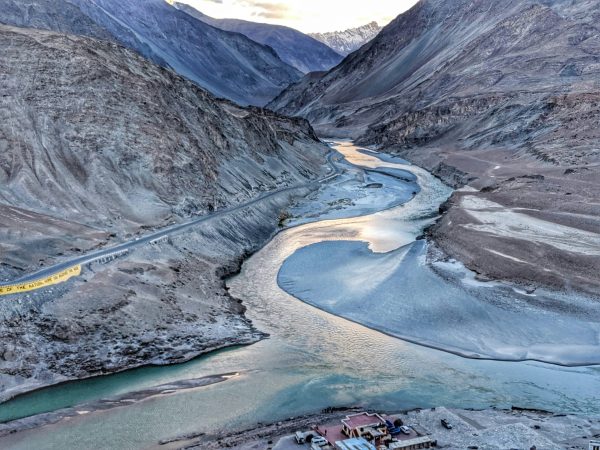Imagine sitting in the foothills of Mount Kailash with its peak gently wrapped with an orange tinted sunset. Almost everyone would feel amazed by nature’s magic and would have no trouble surrendering to such an indescribable sacred or great mystery, whether one is spiritual or not. This great mountain nestled in the high plateau of Tibet is regarded as sacred from its summit to the bottom. Tantric Buddhists and Hindus travel from far away to cleanse their minds and bless their hearts through the power of seeing its sacredness, which lies in the eyes of those devotees who believe it is an abode of the divine. This worship is the act of witnessing the sacred in nature, not just in man-made totems, temples, scriptures, and statues.
The question is, whether the sacred lies only in those chosen places or is all of nature sacred? If the sacred lies only in bounded spatial limits, then most of the realms of nature are not sacred. What impact would such an outlook bring to our relationship with the natural world? Would it bring harmony or conflict?
This worship is the act of witnessing the sacred in nature, not just in man-made totems, temples, scriptures, and statues.
Instead of seeing the sacred only in particular natural places, we must try to feel that the sacred lies everywhere, in every forest, every river, every tree, and even every leaf. This perception will have a benevolent impact, bringing healing and joy to our lives, which are intertwined with nature in the eternal knot of the interdependence of all things. Many people in Tibet feel that nature is not just a dead object that can be conquered and exploited, but instead that mountains, rivers, and trees are the abode of Spirit. If they cut a tree, they will not do it carelessly but with reverence. Even today, when some Tibetans construct a road in the mountains, they will make a ceremonial offering to the mountain before they dig the ground.
The modern world, led by the West, whose world view is heavily colored by science, is not known for seeing nature as sacred. For a long time, Western culture saw nature as man’s property to conquer and exploit as much as possible, considering it an inanimate thing devoid of soul. That culture even regards animals as soulless creatures given by the lord for humanity’s use, so there is little conscience about slaughtering cows, pigs, and horses for food, or using animals as a means of transportation.

Tantric Buddhism holds a very different outlook. It views nature as sacred. In its archetypal model, known as the five Buddha families, all elements—earth, water, fire, air, and space—are viewed as female Buddhas. For example, earth is regarded as Buddhalochana who is intrinsically pure, free, and faultless. Water is Mamaki, a female Buddha who is the most sublime of all the sublime. Tantric Buddhism teaches that the nature of all beings, including animals, has been Buddha all along. Sometimes, this can be very radical to the mind of the mundane world that is trapped in an arbitrary system of a hierarchy of living beings. A real Tantric Buddhist master would not have a problem bowing to a rock, an ordinary person, or an animal. She might not do that in public to observe the conventional norms. It said that Dzogchen master Do Drubchen Jigme Trinley Odzer of Tibet said that he sometimes felt moved by the thought of bowing to every being he ran into on the road. Mahayana Buddhism’s main doctrine is the theory of Buddha nature, tathagatagarbha, or divinity that pervades all living beings. Some go so far as to state that all things including rocks and dust, are pervaded by Buddha nature. In any case, all beings, regardless of their form or their type of walking—on two legs or four legs—and so on, are equally seen as Buddhas in their true nature. This view helps us to learn to respect all animals, something that seems to be missing in the Western conventional religious teachings.
Many destructive marks of not seeing nature’s sacredness are being left everywhere. Examples of man’s careless actions are so abundant that they cannot be counted. One time, a group of us visited a majestic redwood grove nestled in a unique ecosystem in close proximity to the coast in Northern California. These tall towering trees are so splendid that they take your breath away with amazement and give you the feeling that you’re walking in the land of sprits or magic. It can be easily regarded as a wonder of the world. One person began to tell the history of the grove from what he had heard. He said that there was a very ancient redwood, which was the tallest among its peers. It sounded exquisitely majestic. Eventually it was cut down for the timber business. This story immediately brought grief to me. The men who cut it down probably didn’t see the sacredness or unbearable beauty of the tree. They had a choice not to go after her. Perhaps they dove into the intoxicating pride of being powerful by conquering this mighty tree that stood as the queen of the forest.
This is not about being against development and progress. The modern world has achieved an unprecedented level of scientific and technological advances, which our ancestors could not even imagine. It has brought a slew of benefits to each of us—we have no desire to change course and go back to the way we used to live centuries ago. This is about changing our mechanical and material attitude, and learning how to respect and see the sacredness of nature among all living things. If humanity continues to be lost in the mentality of exploiting nature, it will not only cause environmental degradation, but we will all lose something truly precious: our spiritual bond with nature. It is time for us to revive the ancient wisdom that can open our eyes to recognize the sanctity of all things. We must have hope for a big change in the consciousness of the general society.
This article was originally published on Buddhistdoor Global. It is reprinted here with permission.







